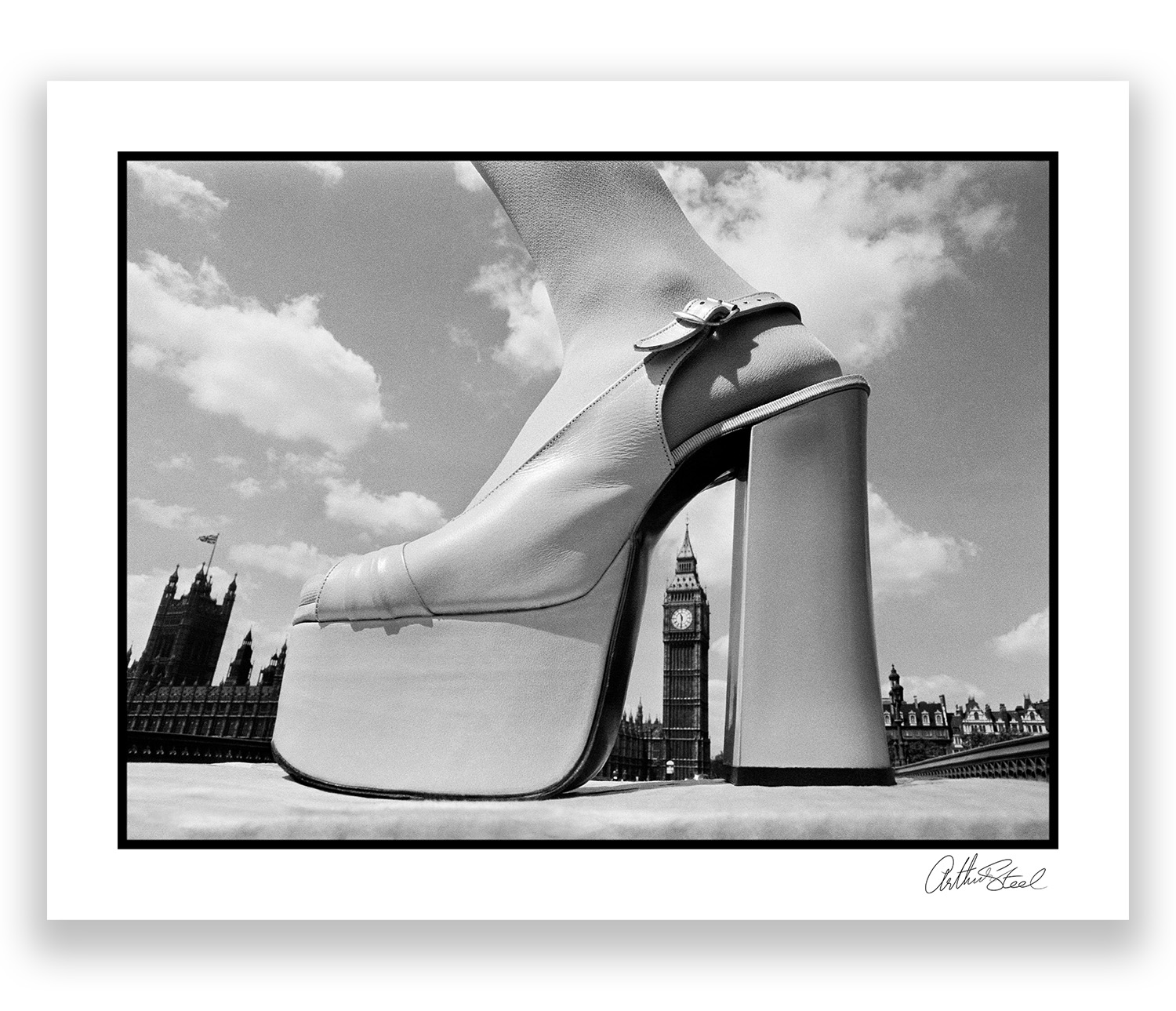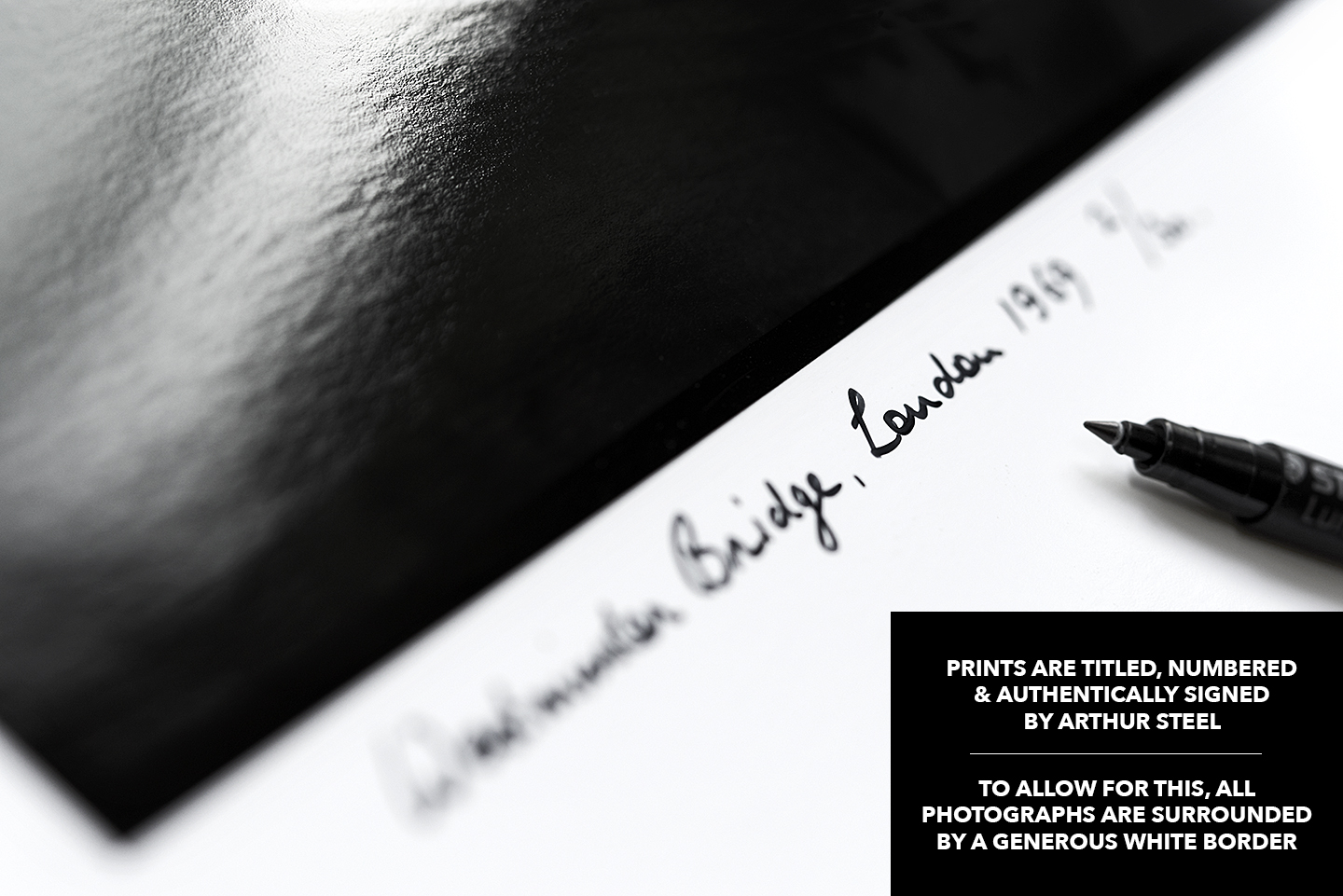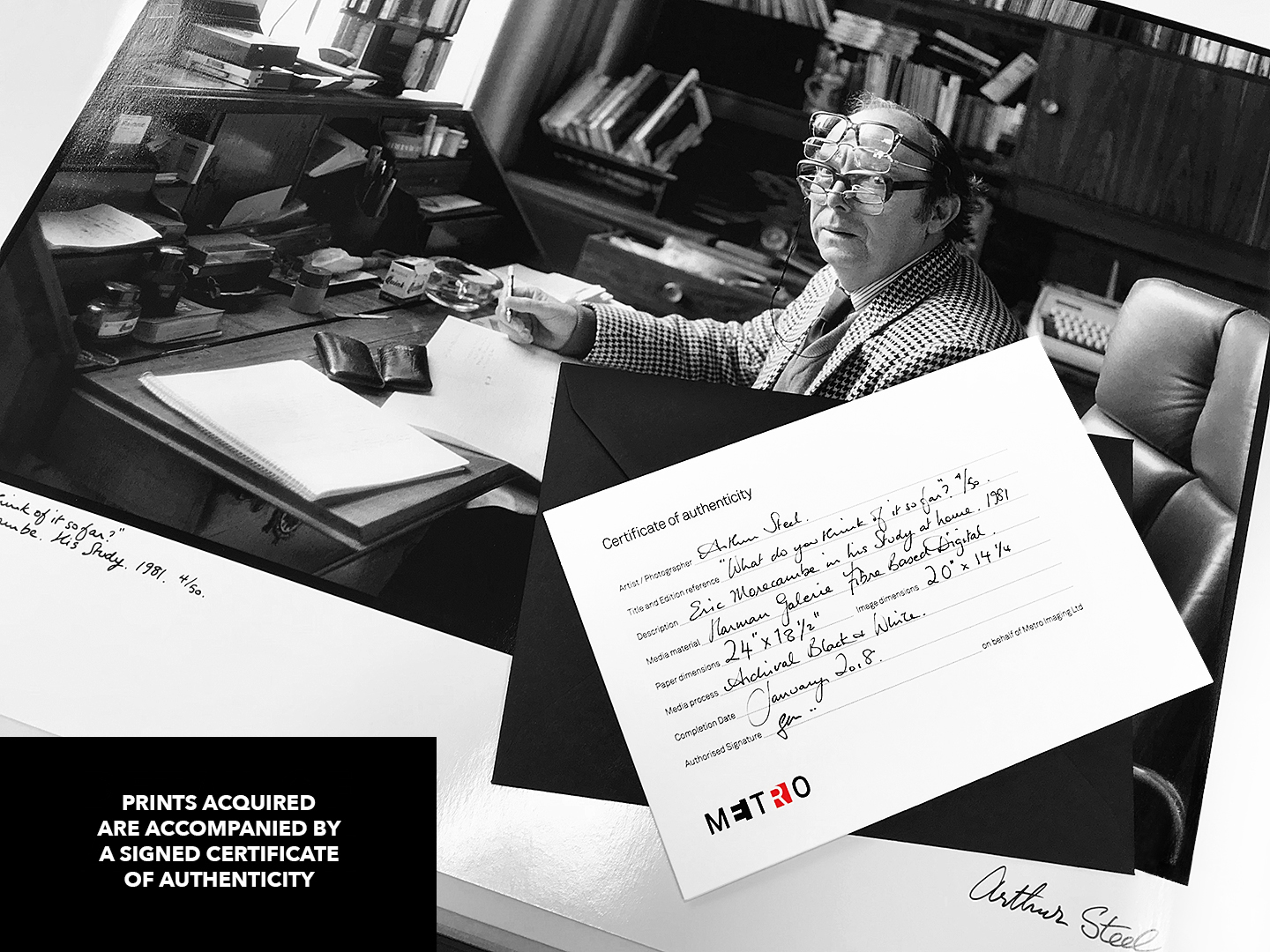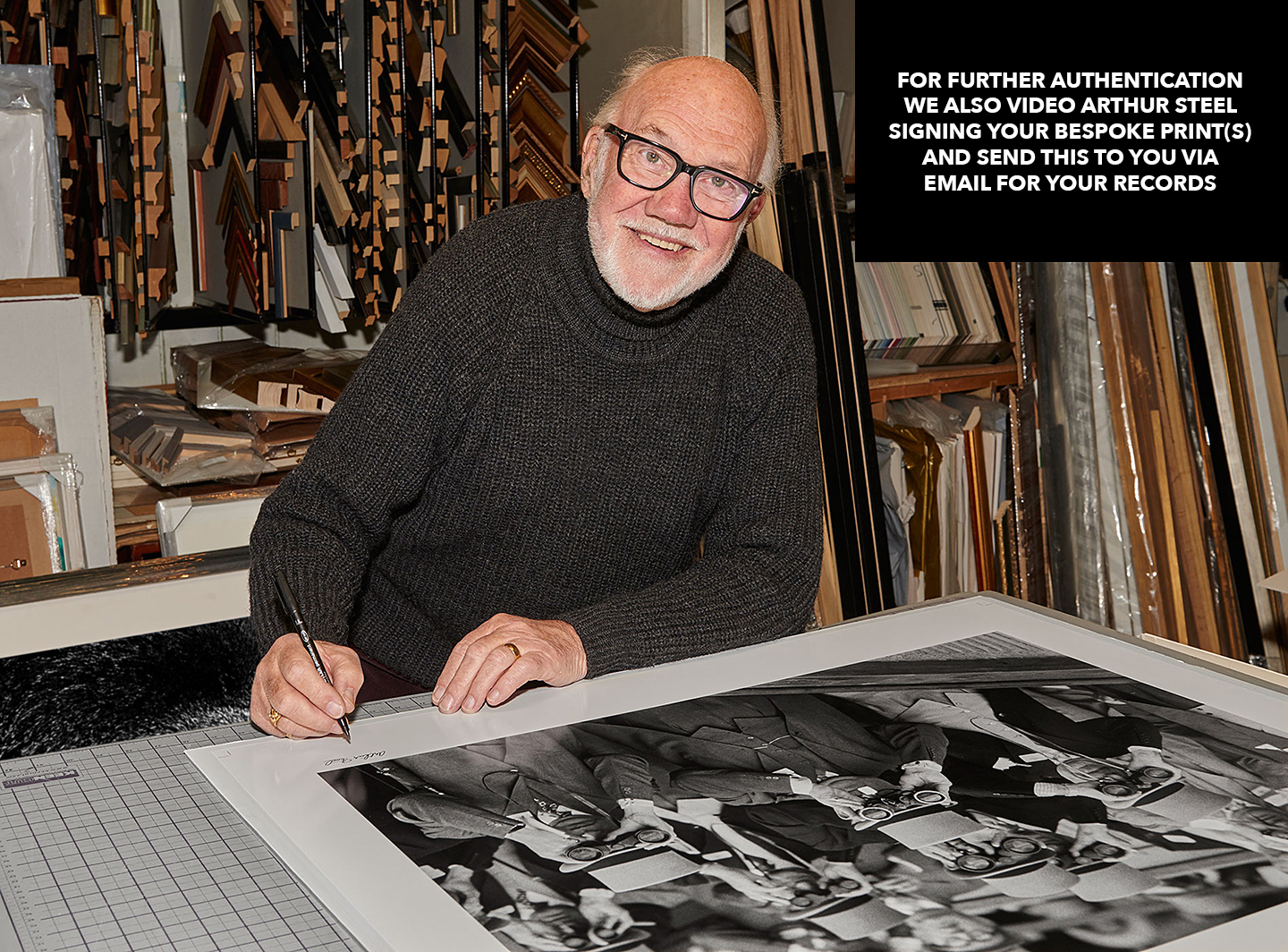Description
An exclusive limited edition photograph by Photojournalist Arthur Steel.
A model’s platform shoe arches over Queen Elizabeth Tower on Westminster Bridge, London.
Arthur recalls: “I’d just acquired a 19mm lens for my Leica flex SL9 and was keen to explore it’s ability to focus very close-up. Platform shoes were all the rage at the time and I took one of the girls from the office to Westminster Bridge and lay on the pavement to get this shot framing Queen Elizabeth Tower inside the arch of the shoe.”
✓ Exceptionally rare limited edition photograph.
✓ Direct from the Artist.
✓ Non licensable images.
✓ Printed by Metro Imaging.
✓ Hand signed by Arthur Steel.
✓ Video of Arthur Steel signing your print(s).
✓ Certificate of Authenticity.
✓ Free worldwide delivery.
✓ Tracked & signed for delivery.
✓ Paypal Pro protection.
✓ Secure SSL payment protection.
✓ 14 day money back guarantee.
✓ Excellent customer care and service.
Black & White Film Grain:
Arthur’s photographs were all captured on 35mm film, a fast medium grain film called ‘Kodak Tri-x Pan’ with an ISO speed of 400. It enabled photojournalists at the time to shoot in relatively low light conditions. Nowadays, we are used to grainless images even at an iso of 800 and above. The grain effect adds to the character and charm of the images and dates the pieces accordingly. Arthur’s images cannot to be compared to todays grainless digital technology.
Signed prints Vs. Unsigned prints:
Most artists sign their prints at the bottom right corner of the piece. By signing a print, the artist approves it, and, claims it as his or her own work. Signatures count for a lot on the print market since they add to the artwork’s authenticity. The value of a signed print is higher than the value of an unsigned print, so if you have a choice, it’s always better to acquire signed prints.
Limited editions Vs. Open editions:
As a rule limited edition prints are valued more highly and therefore are priced higher than the readily available open edition prints. Also, limited edition prints are collectible, which is not the case for open edition prints. Due to their scarcity, limited edition prints are prized, and collectors and art lovers will seek to create a collection of the same.
Camera: Leica 35mm.
Film stock: Kodak Tri-X Pan.
Location: Westminster Bridge, London.
Year: 1973.
Collection: Platinum.
Print Type: Fibre-based Harman Galerie FB Digital.
Printed by: Metro Imaging.
Limited Editions:
All prints are limited editions, no further prints are produced once sold.
60″ prints / edition of 5
50″ prints / edition of 10
40″ prints / edition of 20
30″ prints / edition of 30
20″ prints / edition of 50
12″ prints / edition of 50
Bespoke: All prints are bespoke and printed to order.
Presentation: 12 and 20 inch prints are titled, numbered, signed and carefully enfolded in acid free tissue paper, supplied flat in an acid free 4mm 3-ply box for delivery and storage purposes. The boxes are ideal for gift wrapping. The larger 30, 40, 50 and 60 inch prints are also titled, numbered, signed and carefully enfolded in acid free tissue paper and inserted into a rigid 4mm thick protective cardboard tube for delivery.
Optional Dry Mounting for clients within the UK: Professional Dry Mounting of the larger print sizes can be arranged at no extra cost, the print would then be perfectly flat and ready for framing. However, this makes the overall size bulky and too fragile to send overseas. So, if you reside abroad, it is best that we send a rolled print directly to your chosen framer and you entrust them to carry out the works for you. We recommend that you check that your framer is fully insured as we cannot take responsibility for any damages that may occur during the mounting/framing process.
Delivery: Metro Imaging based in Central London use an experienced shipping service to deliver the boxed and rolled prints. Metro take great care in ensuring the print(s) are very well protected and efficiently delivered anywhere in the UK or overseas. Acid free tissue paper protects prints from scratching/creasing. Metro also offer a vast array of delivery options to suit the recipient’s preference.
Certificate of Authenticity: Each print acquired from The Arthur Steel Archive is accompanied by an individually signed Certificate of Authenticity.
Video of Authenticity: Newly printed bespoke prints are further authenticated by way of a short personalised video. Arthur Steel mentions your name on the recording prior to signing. For example, Arthur will say something like: “I’m signing this print of ‘Well Heeled’, edition number 2/20 for Mr. Smith in New York.” For your records, the footage is then sent to you via email.
Watermark: Watermarks will not be present on an original print.
Copyright: © Arthur Steel / The Arthur Steel Archive.
Information: 1970s fashion, which began with a continuation of the mini skirts, bell-bottoms and the androgynous hippie look from the late 1960s, was soon sharply characterised by several distinct fashion trends that have left an indelible image of the decade commemorated in popular culture. These include platform shoes which appeared on the fashion scene in 1971 and often had soles two to four inches thick. These were worn by both men and women. Wide-legged, flared jeans and trousers were another fashion mainstay for both sexes throughout most of the decade and this style has been immortalised in the 1977 film Saturday Night Fever, which starred John Travolta. The “disco look”, complete with three-piece suits for men and rayon or jersey wrap dresses for women, which the film further popularised, lasted until it was gradually replaced by punk fashion and straight, cigarette-legged jeans. Platform shoes gave way to mules and ankle-strapped shoes, both reminiscent of the 1940s, at the very end of the decade.
Elizabeth Tower: Big Ben is the nickname for the Great Bell of the clock at the north end of the Palace of Westminster in London and is usually extended to refer to both the clock and the clock tower. The tower in which Big Ben is located is officially called the Elizabeth Tower; originally just the Clock Tower, it was renamed in 2012 for the Diamond Jubilee of Elizabeth II.
The tower was designed by Augustus Pugin in a neo-gothic style. When completed in 1859, it was, says horologist Ian Westworth, “the prince of timekeepers: the biggest, most accurate four-faced striking and chiming clock in the world”. It stands 315 feet (96 m) tall, and the climb from ground level to the belfry is 334 steps. Its base is square, measuring 39 feet (12 m) on each side. Dials of the clock are 23 feet (7.0 m) in diameter. On 31 May 2009, celebrations were held to mark the tower’s 150th anniversary.
Big Ben is the largest of five bells and weighs 13 1⁄2 long tons (13.7 tonnes; 15.1 short tons). It was the largest bell in the United Kingdom for 23 years. The origin of the bell’s nickname is open to question; it may be named after Sir Benjamin Hall, who oversaw its installation, or boxing heavyweight champion Benjamin Caunt. Four quarter bells chime at 15, 30 and 45 minutes past the hour and just before Big Ben tolls on the hour. The clock uses its original Victorian mechanism, but an electric motor can be used as a backup.
A British cultural icon, recognised all over the world, the tower is one of the most prominent symbols of the United Kingdom and parliamentary democracy, and it is often used in the establishing shot of films set in London. The clock tower has been part of a Grade I listed building since 1970 and a UNESCO World Heritage Site since 1987.
On 21 August 2017, a four-year schedule of renovation works began on the tower, which are to include the addition of a lift. There are also plans to re-glaze and repaint its dials. With a few exceptions, such as New Year’s Eve and Remembrance Sunday, the bells are to be silent until the work has been completed in the 2020’s.
Westminster Bridge is a road-and-foot-traffic bridge over the River Thames in London, linking Westminster on the west side and Lambeth on the east side.
The bridge is painted predominantly green, the same colour as the leather seats in the House of Commons which is on the side of the Palace of Westminster nearest to the bridge. This is in contrast to Lambeth Bridge, which is red, the same colour as the seats in the House of Lords and is on the opposite side of the Houses of Parliament.
In 2005–2007, it underwent a complete refurbishment, including replacing the iron fascias and repainting the whole bridge. It links the Palace of Westminster on the west side of the river with County Hall and the London Eye on the east and was the finishing point during the early years of the London Marathon.
The next bridge downstream is the Hungerford footbridge and upstream is Lambeth Bridge. Westminster Bridge was designated a Grade II listed structure in 1981.







Recent Comments